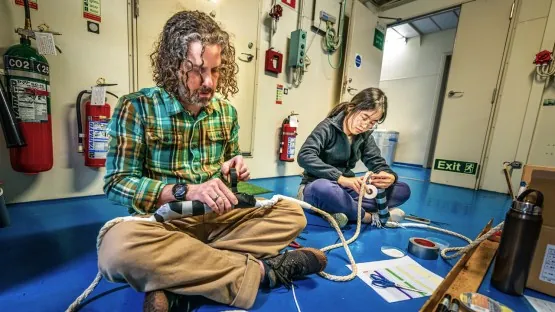
Groundbreaking Discoveries Beneath the Japan Trench: Unlocking the Secrets of Tsunami Generation
2025-01-06
Author: Sarah
Introduction
In a remarkable feat of scientific exploration, an international marine research team, led by experts from Cornell University, has successfully completed an ambitious drilling project in the Japan Trench. This initiative aims to unravel the mysteries behind the 2011 Tohoku earthquake, which devastated large portions of Japan and triggered a catastrophic tsunami.
Scientific Endeavors at Great Depths
Operating at staggering ocean depths of 7 kilometers, the team utilized the state-of-the-art Japanese drilling vessel Chikyu to drill several deep boreholes, including a pioneering sub-seafloor observatory that penetrates nearly 1 kilometer beneath the seafloor. This groundbreaking work involved comprehensive geophysical logging and coring, as well as reinstallation of temperature sensors in a pre-existing observatory well. Notably, no other team has attempted such depths before, underscoring the project's unprecedented nature.
Implications of the Research
The implications of this research are profound. According to Patrick Fulton, a leading expert in Earth and atmospheric sciences at Cornell, these investigations will significantly enhance our understanding of subduction zones, which are critical in predicting large earthquakes and tsunamis. The findings could lead to advancements in disaster preparedness and risk mitigation strategies.
The Complexity of the Mission
Fulton, who played a pivotal role as co-chief scientist, likened the complexities of this project to a NASA mission. "We're dealing with ultra-deep water, penetrating further underground. Not many ships can operate in such challenging conditions," he explained. The team's previous efforts, dating back to a similar drilling expedition in 2012, laid the groundwork for this advanced research.
Seismic Activity Revealed
The initial study revealed that during the Tohoku earthquake, the fault slipped dramatically – a staggering 50 to 60 meters. This seismic activity resulted in the seafloor moving almost half a football field to the east in just a minute or two, generating a tsunami larger than anticipated at the time. Now, twelve years later, researchers are dive deep to ascertain how the geological dynamics have evolved.
Monitoring Stress Levels
Critical to their investigations is the observatory established during the initial drilling expedition, which provided valuable insights into the fault's conditions. As the team studies the current stress levels and characteristics of the faults, they aim to understand whether the fault has built up enough stress for another significant rupture.
Technical Challenges Overcome
Reentering the borehole for the second time proved to be a significant technical challenge. The team, comprising around 150 members, including scientists, engineers, and skilled drillers, overcame these hurdles using advanced tools like fiber optic cables and sonar to accurately navigate the drill pipe back to the correct position—a process as complex as threading a needle from great heights.
Advanced Research Techniques
Once back in position, they quickly drilled over 900 meters across the fault and installed sophisticated sensors designed to measure fluid dynamics and heat caused by friction. This marks the evolution of their research focus toward understanding hydrology within fault systems—one of the key elements in predicting the behavior of these geological structures.
Innovations in Sensor Technology
Moreover, new methodologies involving titanium casing for sensors were developed to withstand ocean pressure, amplifying the strength and reliability of their measurements. By collecting core samples and implementing meticulous logging techniques, the researchers are on the brink of transforming seismic science, potentially leading to groundbreaking publications as they analyze their data.
Conclusion and Future Outlook
As they conclude this phase of the project with the installation of an even deeper borehole observatory, Fulton and his team are eager to share their findings with the broader scientific community. "This is a major initiative in earthquake science. While we may not possess the budget of space missions, the knowledge we're gaining could redefine our understanding of earthquakes and tsunamis," Fulton declared. Stay tuned for more updates as this innovative research continues to illuminate the hidden dynamics of our planet’s seismic activity!


 Brasil (PT)
Brasil (PT)
 Canada (EN)
Canada (EN)
 Chile (ES)
Chile (ES)
 Česko (CS)
Česko (CS)
 대한민국 (KO)
대한민국 (KO)
 España (ES)
España (ES)
 France (FR)
France (FR)
 Hong Kong (EN)
Hong Kong (EN)
 Italia (IT)
Italia (IT)
 日本 (JA)
日本 (JA)
 Magyarország (HU)
Magyarország (HU)
 Norge (NO)
Norge (NO)
 Polska (PL)
Polska (PL)
 Schweiz (DE)
Schweiz (DE)
 Singapore (EN)
Singapore (EN)
 Sverige (SV)
Sverige (SV)
 Suomi (FI)
Suomi (FI)
 Türkiye (TR)
Türkiye (TR)
 الإمارات العربية المتحدة (AR)
الإمارات العربية المتحدة (AR)